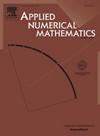基于变分多尺度概念的对流扩散反应方程有限元近似的后验误差估计
IF 2.4
2区 数学
Q1 MATHEMATICS, APPLIED
引用次数: 0
摘要
在这项研究中,我们采用变分多尺度(VMS)的概念来建立稳态对流-扩散-反应方程的后验误差估计。变分多尺度方法是将问题的连续部分分解为一个已解尺度(粗尺度)和一个未解尺度(细尺度)。通过选择与有限元空间正交的残差分量成比例的未解析尺度(也称为子网格尺度)来建模,从而产生正交子网格尺度(OSGS)方法。然后,我们的想法是使用建模的子网格尺度作为误差估计器,考虑到它在元素内部和边缘的贡献。我们给出了先验分析的结果和两种不同的策略,用于OSGS方法的后验误差分析。我们的建议是使用子网格尺度的缩放范数作为问题的所谓稳定范数的后验误差估计。该范数可以控制对流项,这对于对流主导的问题是必要的。数值算例表明,与其他的变分多尺度误差估计器相比,所提出的误差估计器具有可靠的性能。本文章由计算机程序翻译,如有差异,请以英文原文为准。
A posteriori error estimates for the finite element approximation of the convection–diffusion–reaction equation based on the variational multiscale concept
In this study, we employ the variational multiscale (VMS) concept to develop a posteriori error estimates for the stationary convection-diffusion-reaction equation. The variational multiscale method is based on splitting the continuous part of the problem into a resolved scale (coarse scale) and an unresolved scale (fine scale). The unresolved scale (also known as the sub-grid scale) is modeled by choosing it proportional to the component of the residual orthogonal to the finite element space, leading to the orthogonal sub-grid scale (OSGS) method. The idea is then to use the modeled sub-grid scale as an error estimator, considering its contribution in the element interiors and on the edges. We present the results of the a priori analysis and two different strategies for the a posteriori error analysis for the OSGS method. Our proposal is to use a scaled norm of the sub-grid scales as an a posteriori error estimate in the so-called stabilized norm of the problem. This norm has control over the convective term, which is necessary for convection-dominated problems. Numerical examples show the reliable performance of the proposed error estimator compared to other error estimators belonging to the variational multiscale family.
求助全文
通过发布文献求助,成功后即可免费获取论文全文。
去求助
来源期刊

Applied Numerical Mathematics
数学-应用数学
CiteScore
5.60
自引率
7.10%
发文量
225
审稿时长
7.2 months
期刊介绍:
The purpose of the journal is to provide a forum for the publication of high quality research and tutorial papers in computational mathematics. In addition to the traditional issues and problems in numerical analysis, the journal also publishes papers describing relevant applications in such fields as physics, fluid dynamics, engineering and other branches of applied science with a computational mathematics component. The journal strives to be flexible in the type of papers it publishes and their format. Equally desirable are:
(i) Full papers, which should be complete and relatively self-contained original contributions with an introduction that can be understood by the broad computational mathematics community. Both rigorous and heuristic styles are acceptable. Of particular interest are papers about new areas of research, in which other than strictly mathematical arguments may be important in establishing a basis for further developments.
(ii) Tutorial review papers, covering some of the important issues in Numerical Mathematics, Scientific Computing and their Applications. The journal will occasionally publish contributions which are larger than the usual format for regular papers.
(iii) Short notes, which present specific new results and techniques in a brief communication.
 求助内容:
求助内容: 应助结果提醒方式:
应助结果提醒方式:


